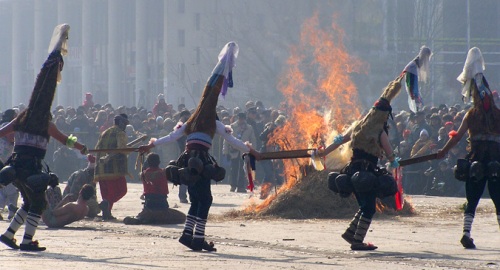
The reign of King David Kālakaua holds special significance for Hawaiian traditions. After decades of missionary-led censure, Hawaiian customs became revitalized when Kalākaua encouraged their revival. Master teachers (kumu hula) were summoned to the court at Honolulu, where they enjoyed royal patronage. From the environment, hula ku‘i emerged as a new style of dancing.
The term ku‘i means “to join old and new”, and refers to the mix of old and new components of poetry, music, dance, and costume. Traditional conventions gained a new format: texts were strophic, and each strophe consisted of a couplet. Indigenous vocal styles and ornaments were added to melodies based on tempered tones and simple harmonies. Each couplet was uniform in length, most commonly eight or sixteen beats. The format mandated the repetition of the melody for each couplet, and each couplet was commonly performed twice. An instrumental interlude, popularly called a vamp, separated the stanzas. In dances by seated performers, this interlude is called ki’i pā. New sequences of movements joined preexisting, named, lower-body motifs.
The defining distinction of the hula ku‘i was accompaniment from guitars and ‘ukulele. For dances by standing performers, mele composed in the new format also had the accompaniment of ipuor other Indigenous percussive instruments. In the 20th century, performances of those mele came to be called either ancient hula or hula ‘ōlapa, referencing the division of labor between dancers (‘ōlapa) and musicians (ho’opa’a).
Read the entry on hula ku‘i by Amy Ku‘uleialoha Stillman in The Garland encyclopedia of world music. Australia and the Pacific Islands (2013). Find it in RILM Music Encyclopedias (RME).
The image above is of hula dancers and musicians, circa 1883. Photo courtesy of the Hawai’i State Archives. Below is a video of Hawaiian dance and music from the 2019 Merrie Monarch Festival held annually in Hilo, Hawaii.




 On the eve of the event, youths go from house to house collecting wood for the ceremonial bonfire. In the morning the participants choose their roles and don the corresponding masks and sheepskin capes. The stock characters may include a groom, a bride, a devil, a priest, a gypsy, and a dancer with a bear. To the accompaniment of drums and shawms, the dancers parade through the village with abundant comical antics. The ceremony culminates with a spirited dance around the collective bonfire.
On the eve of the event, youths go from house to house collecting wood for the ceremonial bonfire. In the morning the participants choose their roles and don the corresponding masks and sheepskin capes. The stock characters may include a groom, a bride, a devil, a priest, a gypsy, and a dancer with a bear. To the accompaniment of drums and shawms, the dancers parade through the village with abundant comical antics. The ceremony culminates with a spirited dance around the collective bonfire.
